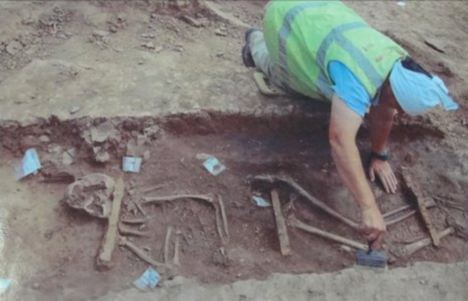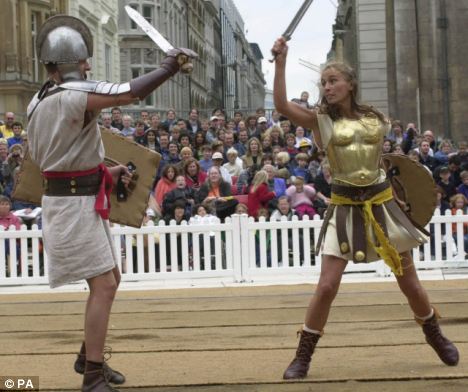Archaeologists have uncovered the remains of someone who they think may have been a British female gladiator.
The skeleton of a 'massive, muscular woman' was found in an elaborate wooden coffin with iron straps and copper strips in Credenhill, Herefordshire - close to the headquarters of the SAS.
Her remains were found in a crouched position in an area thought to be a suburb of the nearby Roman town of Kenchester. An offering of beef and a fired pot were also found in the grave.
A road from Kenchester was constructed in the mid 1st Century by the Romans and leads into nearby Wales, which they also conquered.
Around 20 Roman ampitheatres have so far been discovered in Britain, the largest being in Chester. Gladiators are known to have fought each other - and animals - in them.
Archaelogists find 'muscular' body of British 'female gladiator'
By Daily Mail Reporter
2nd July 2010
Daily Mail
Archaeologists have uncovered the remains of a 'massive, muscular woman' who may have been a female gladiator during the Roman occupation of Britain.
The woman was buried in an elaborate wooden coffin with iron straps and copper strips in Credenhill, Herefordshire - close to the headquarters of the SAS.
Her remains were found in a crouched position in an area thought to be a suburb of the nearby Roman town of Kenchester.

Archaeologists uncover the remains of what could possibly be a female gladiator
Archaeological Project Manager Robin Jackson said: 'When we first looked at the leg and arm bones, the muscle attachments suggested it was quite a strapping big bloke.
'But the pelvis and head, and all the indicators of gender, say it's a woman.'
He said one explanation could be that she was a female gladiator.
'The coffin would have been made of wood - we haven't got any of the wood left, but we've got the nails around the outside then three huge giant straps that run all the way around the coffin, and also bronze strips on the corners which would have probably strengthened it, but probably decorated it.
'It's quite an elaborate and probably a very expensive coffin, and yet the person in it looked like they had a hard working life, and so there's an anomaly there.'
An offering of beef and a fired pot were also found in the grave, and she was buried on top of a base of gravel.
Also unusual was the place where she was buried - in the suburb, instead of in a cemetery on the edge of the settlement, which was the law in Roman times.
The archaeological find is as a result of excavations in advance of the construction of the Yazor Brook Flood Alleviation Scheme, which will protect homes and businesses in Hereford.
The road east from Kenchester was constructed by the Roman army in the mid 1st century AD, as they pushed westwards into Wales.

A female gladiator does battle in this reenactment in London. Archaeologists believe they may have found the remains of a female gladiator in the UK
Very little was known previously about the suburb which grew up beside this road, however, preliminary results suggest that the main period of development for the suburb was the 2nd and 3rd centuries AD.
Scientists believe that it was much more extensive and densely occupied than had previously been thought.
Work in 2009 showed that the area contains the well-preserved remains of Roman buildings, yards and rubbish pits situated to either side of a major Roman road, which ran east out of the town.
These form part of an important Roman suburb, which developed alongside the road, but now lies buried, along with the rest of the town, beneath fields and a footpath.
A team of archaeologists from Worcestershire Historic Environment and Archaeology Service, working in close co-operation with Amey Consulting and Herefordshire Council's archaeology team, are carefully excavating a 10-metre wide corridor, to allow the flood culvert to be built across this area.
A huge amount of information has already been gleaned, and this is beginning to allow the archaeologists to gain an understanding of this part of the town.
It is hoped that by the time the excavation is completed, at the end of July 2010, the archaeological team will have built up a detailed understanding of the development and nature of this Roman suburb.
dailymail.co.uk
The skeleton of a 'massive, muscular woman' was found in an elaborate wooden coffin with iron straps and copper strips in Credenhill, Herefordshire - close to the headquarters of the SAS.
Her remains were found in a crouched position in an area thought to be a suburb of the nearby Roman town of Kenchester. An offering of beef and a fired pot were also found in the grave.
A road from Kenchester was constructed in the mid 1st Century by the Romans and leads into nearby Wales, which they also conquered.
Around 20 Roman ampitheatres have so far been discovered in Britain, the largest being in Chester. Gladiators are known to have fought each other - and animals - in them.
Archaelogists find 'muscular' body of British 'female gladiator'
By Daily Mail Reporter
2nd July 2010
Daily Mail
Archaeologists have uncovered the remains of a 'massive, muscular woman' who may have been a female gladiator during the Roman occupation of Britain.
The woman was buried in an elaborate wooden coffin with iron straps and copper strips in Credenhill, Herefordshire - close to the headquarters of the SAS.
Her remains were found in a crouched position in an area thought to be a suburb of the nearby Roman town of Kenchester.

Archaeologists uncover the remains of what could possibly be a female gladiator
Archaeological Project Manager Robin Jackson said: 'When we first looked at the leg and arm bones, the muscle attachments suggested it was quite a strapping big bloke.
'But the pelvis and head, and all the indicators of gender, say it's a woman.'
He said one explanation could be that she was a female gladiator.
'The coffin would have been made of wood - we haven't got any of the wood left, but we've got the nails around the outside then three huge giant straps that run all the way around the coffin, and also bronze strips on the corners which would have probably strengthened it, but probably decorated it.
'It's quite an elaborate and probably a very expensive coffin, and yet the person in it looked like they had a hard working life, and so there's an anomaly there.'
An offering of beef and a fired pot were also found in the grave, and she was buried on top of a base of gravel.
Also unusual was the place where she was buried - in the suburb, instead of in a cemetery on the edge of the settlement, which was the law in Roman times.
The archaeological find is as a result of excavations in advance of the construction of the Yazor Brook Flood Alleviation Scheme, which will protect homes and businesses in Hereford.
The road east from Kenchester was constructed by the Roman army in the mid 1st century AD, as they pushed westwards into Wales.

A female gladiator does battle in this reenactment in London. Archaeologists believe they may have found the remains of a female gladiator in the UK
Very little was known previously about the suburb which grew up beside this road, however, preliminary results suggest that the main period of development for the suburb was the 2nd and 3rd centuries AD.
Scientists believe that it was much more extensive and densely occupied than had previously been thought.
Work in 2009 showed that the area contains the well-preserved remains of Roman buildings, yards and rubbish pits situated to either side of a major Roman road, which ran east out of the town.
These form part of an important Roman suburb, which developed alongside the road, but now lies buried, along with the rest of the town, beneath fields and a footpath.
A team of archaeologists from Worcestershire Historic Environment and Archaeology Service, working in close co-operation with Amey Consulting and Herefordshire Council's archaeology team, are carefully excavating a 10-metre wide corridor, to allow the flood culvert to be built across this area.
A huge amount of information has already been gleaned, and this is beginning to allow the archaeologists to gain an understanding of this part of the town.
It is hoped that by the time the excavation is completed, at the end of July 2010, the archaeological team will have built up a detailed understanding of the development and nature of this Roman suburb.
dailymail.co.uk